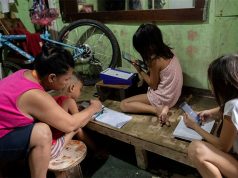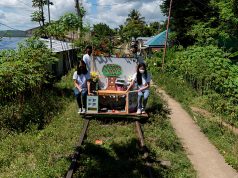
MANILA – Schooling is not the same as learning, and experts from the World Bank Group have found that hundreds of millions of children in developing countries reach young adulthood without even the most basic life skills despite spending years inside the classroom.
This means they can’t calculate the correct change from a transaction, can’t read a doctor’s instructions, and can’t interpret a politician’s campaign promise. What more build their own career or educate their own children?
“Schooling without learning is a wasted opportunity. More than that, it is a great injustice: the children whom society is failing most are the ones who most need a good education to succeed in life,” said economist Halsey Rogers and education specialist Michael Crawford, who wrote the World Bank’s first World Development Report focused exclusively on Education, “Learning to Realize Education’s Promise”.
The two were the guest speakers on Tuesday at the 2018 Policy Forum on Education at the Makati Shangri-La, hosted by education reform advocates Philippine Business for Education (PBEd).
PBEd Chairman Ramon del Rosario noted that only 34 percent of Filipino primary school students meet the global standards of math proficiency.
This means the mastery of “basic mathematical skills, whether making simple computations with whole numbers, using fractions or measurements, or interpreting simple bar graphs,” according to the World Bank study.
The authors argued that “many features of education systems conspire against learning.” Thus, countries can improve by working on the researchers’ three recommendations:
1. Assess learning—to make it a serious goal. This means using well-designed student assessments to gauge the health of education systems (not primarily as tools for administering rewards and punishments). It also means using the resulting learning measures to spotlight hidden exclusions, make choices and evaluate progress.
2. Act on evidence—to make schools work for all learners. Evidence on how people learn has exploded in recent decades, along with an increase in educational innovation. Countries can make much better use of this evidence to set priorities for their own practice and innovations.
3. Align actors—to make the whole system work for learning. Countries must recognize that all the classroom innovation in the world is unlikely to have much impact if, because of technical and political barriers, the system as a whole does not support learning. By taking into account these real-world barriers and mobilizing everyone who has a stake in learning, countries can support innovative educators on the front lines.
The authors stressed that the ultimate barrier to learning is no schooling at all. Unfortunately, hundreds of millions of youth remain out of school. In 2016 alone, 61 million children of primary school age were not in school, along with 202 million children of secondary school age.
‘SCHOOLS FAILING LEARNERS’
At the same time, they said, “schools are failing learners.”
How? “First, children often arrive in school unprepared to learn—if they arrive at all. Malnutrition, illness, low parental investments, and the harsh environments associated with poverty undermine early childhood learning.”
“Second, teachers often lack the skills or motivation to be effective… Most education systems do not attract applicants
with strong backgrounds,” the report said. “Beyond that, weak teacher education results in teachers lacking subject knowledge and pedagogical skills.”
“Third, inputs often fail to reach classrooms or to affect learning when they do.” As an example, the researchers cited Sierra Leone, where textbooks were distributed to schools, but inspections later on showed that these were just collecting dust in cupboards.
In Brazil, a “one laptop per child” initiative was delayed for years, and when the computers did make it to the classrooms, over 40 percent of teachers reported never or rarely using them.
“Fourth, poor management and governance often undermine schooling quality,” said the report. “Ineffective school leadership means school principals are not actively involved in helping teachers solve problems, do not provide instructional advice, and do not set goals that prioritize learning.”
It added that “problems with teacher absenteeism, lack of inputs, and weak management are typically severest in communities that serve the poorest students.”
There are “political challenges” too.
“Politicians act to preserve their positions in power, which may lead them to target particular groups (geographic, ethnic, or economic) for benefits,” the research said. “Some private suppliers of education services—whether textbooks, construction, or schooling—may, in the pursuit of profit, advocate policy choices not in the interest of students. Teachers and other education professionals, even when motivated by a sense of mission, also may fight to maintain secure employment and to protect their incomes.”
In sum, said the authors, “competing interests may loom larger than learning-aligned interests.”
REASONS FOR HOPE
Nevertheless, they said, “there are reasons for hope.”
First, countries can access more information than ever about innovations, interventions, and approaches that have already worked at the level of learners, classrooms, and schools.
Second, some countries have already “implemented reforms that have led to sustained systemwide improvements in learning.”
It noted that in the Philippines, mother tongue instruction has already been initiated. “Children learn to read most effectively in the language they speak at home,” the authors stated.
“Students participating in a pilot in rural Philippines, where they received instruction in their local language, showed significantly higher reading and math scores than students in traditional schools, which used English and Filipino. Beyond its direct learning impacts on them, students receiving instruction in their mother tongue are more likely to attend and persist in school, as demonstrated by data from 26 countries,” they argued.
They added that the “increased skill from learning to read in mother tongue can translate into greater skill in a second language.”
In the pilot project in the Philippines, they noted, “students instructed in their mother tongue also performed better in English reading later on.”
With the wealth of languages in the Philippines, however, they acknowledged that mother tongue instruction requires a major investment in materials and teacher training.









